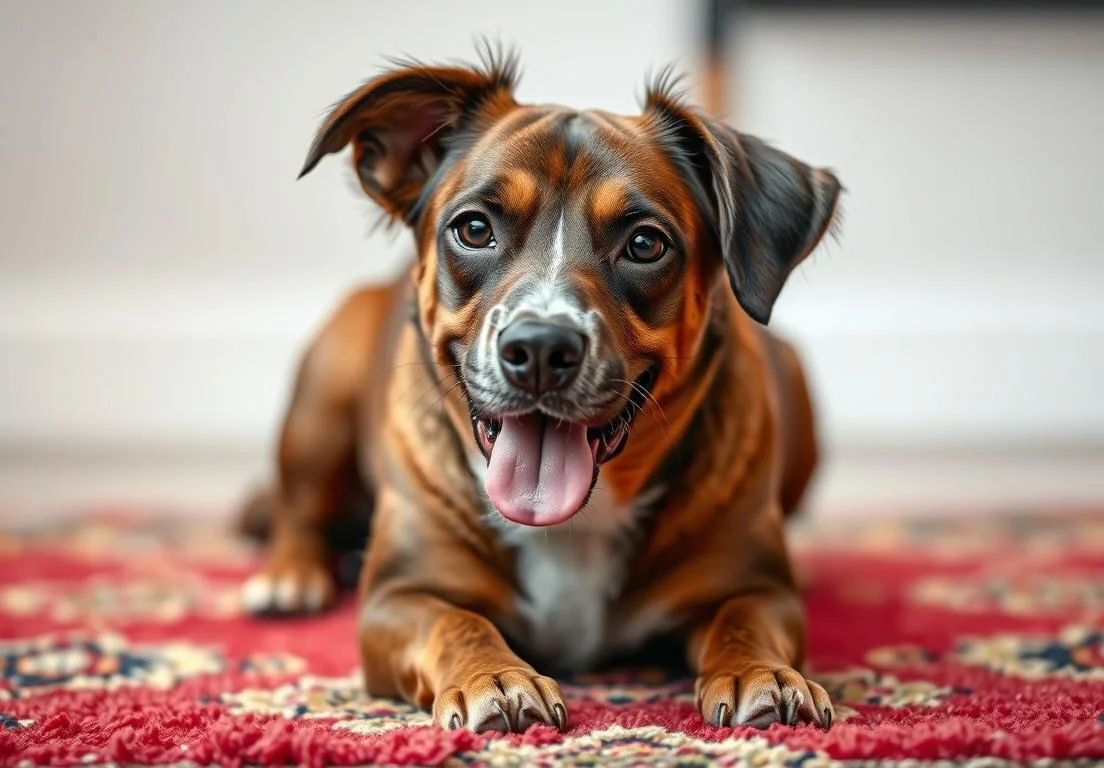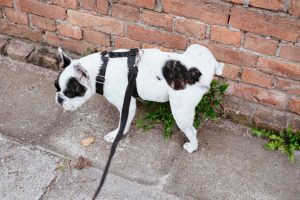Dogs have a way of transforming our homes into their kingdom, but sometimes their royal antics can lead to unexpected messes—like peeing on rugs. If you’ve ever found yourself standing over a soggy carpet, you know the frustration all too well.
So why do dogs choose the rug as their personal restroom? It often boils down to a mix of instincts, marking behavior, and even medical issues. But there’s a surprising array of reasons and insights into how to tackle this problem effectively. Keep reading; you may uncover an intriguing tip or two that could change your home for the better!

What Triggers This Behavior in Dogs?
Multiple triggers can lead dogs to pee on rugs, and understanding these factors is key to addressing the behavior effectively. Territorial instincts often play a significant role. If a new pet or person enters your home, your dog may feel the need to assert dominance by marking a rug, a common spot for scent marking.
Another culprit could be anxiety. Dogs prone to stress might urinate as a way to cope, especially during loud noises, family gatherings, or changes in the household. It’s not uncommon for rescue dogs or those with traumatic pasts to struggle with anxiety-related urination.
Additionally, medical issues like urinary tract infections can cause unexpected accidents. If your dog’s peeing habits change suddenly, it’s wise to consult with a vet to rule out any health concerns.
Finally, laziness during potty training can contribute to this behavior. Sometimes, they might simply prefer the feel of rugs over the cold, hard floor, particularly if they’re young or haven’t yet fully grasped where they’re supposed to go.
Understanding these triggers helps in crafting a tailored approach to prevent the behavior.
Is My Dog Trying to Mark Its Territory?
Scent marking is a natural instinct in dogs, driven by their need to communicate. When dogs urinate on rugs, they often do so to lay claim to their territory and send messages to other animals. This isn’t just about dominance; it can also signal to other dogs that they’ve been there.
To decipher this behavior, consider the context. Is the rug in a high-traffic area? Has a newcomer recently entered their space? When dogs feel threatened or uncertain, marking can be a way to establish comfort and familiarity.
It’s important to note that not all dogs mark in the same way. For some, it may be purely instinctual, while for others, it’s a reaction to stress or anxiety.
If you suspect your dog is engaging in territorial marking, consider these strategies:
- Implement a schedule: Take your dog out regularly to minimize indoor accidents.
- Use odor eliminators: Clean the affected areas thoroughly to remove scent markers.
- Provide safe spaces: Create designated spots where your dog can feel comfortable and secure in their environment.
Recognizing the reasons behind territorial marking not only helps clarify your dog’s behavior but also guides you in effectively managing it.
Could Health Issues Be at Play?
If your dog is urinating on rugs, health issues might be a factor. Conditions like urinary tract infections (UTIs), kidney disease, or diabetes can lead to increased urination or accidents in the house. It’s vital to pay attention to any other signs, like blood in the urine, increased thirst, or changes in appetite, as they can indicate underlying health problems.
A consultation with your vet is crucial if you notice these symptoms. They may recommend tests to rule out any medical issues. Early detection can make all the difference in treatment and your dog’s well-being. Making sure your furry friend is healthy not only impacts their comfort but could also be the key to reducing those rug incidents.
How Can I Properly Train My Dog?
Effective house training is your best bet for preventing those pesky rug accidents. Start by establishing a consistent routine for bathroom breaks. Take your dog out first thing in the morning, after meals, and before bed. This helps reinforce when it’s time to go outside.
Using positive reinforcement is key. Whenever your dog relieves themselves outside, shower them with praise or a small treat right away. Keep in mind that dogs thrive on routines, so try to stick to a similar schedule daily to cement the habit.
Consider the use of crate training as well. Dogs generally don’t like to soil their sleeping area, so with the right approach, crating can encourage them to hold it until they’re outside. Always ensure they have enough time outside to relieve themselves.
Another angle is to pay attention to odors. If your dog smells their own scent on a rug, they might instinctively go back to that spot. Clean any accidents thoroughly using enzyme-based cleaners designed for pet messes. This helps remove lingering smells that can attract a dog to re-soil the area.
Remember, consistency, patience, and understanding are your allies in this training journey.
Are There Specific Breeds More Prone to This?
Certain dog breeds seem to have a more pronounced tendency to urinate indoors than others. Small breeds, like Chihuahuas and Dachshunds, often struggle more because of their bladders’ size and their innate instincts. These dogs may find it easier to mark their territory, as they’re more vulnerable to feeling insecure. Additionally, breeds known for their anxiety, such as Border Collies and German Shepherds, might also exhibit this behavior, especially if their environment isn’t well-suited to their needs.
Moreover, older dogs, regardless of breed, can sometimes have issues with incontinence or health problems, so age is another crucial factor. It’s essential to note, however, that any dog can mistakenly pee on a rug, especially during housebreaking. Focus on your dog’s unique temperament, health, and overall environment to identify specific triggers.
Should I Change My Dog’s Environment?
Your dog’s environment plays a vital role in their behavior. Factors like stress, boredom, or changes in routine can lead to indoor urination. If you recently moved, added a new pet, or even started a new job, your dog might be feeling anxious, which can trigger pee accidents.
Creating a stable routine helps dogs feel secure. Regular feeding and bathroom breaks can significantly minimize the likelihood of accidents. It’s also worth considering the space around your home; if your dog doesn’t have comfortable access to outdoor areas, they may express frustration or anxiety through inappropriate urination.
Here are a few specific changes you might consider:
- Designate a bathroom area outside that your dog can easily access.
- Limit access to rugs or areas where accidents have previously occurred; use gates or crate training as necessary.
- Ensure your dog’s environment is stimulating. Interactive toys or regular exercise can prevent boredom-related behaviors.
By focusing on these environmental factors, you’re setting your dog up for success and reducing the likelihood of indoor accidents.
What Products Help Deter Peeing on Rugs?
To keep your dog from treating your rugs like a bathroom, consider using a combination of products designed specifically to deter unwanted behavior. Enzymatic cleaners are a must; they break down urine crystals and eliminate odors that attract your dog back to the same spot. Look for products like Nature’s Miracle or Rocco & Roxie to really tackle those tough stains.
In addition to cleaners, repellent sprays can be beneficial. Products like PetSafe’s SSSCAT or homemade vinegar solutions can create a scent barrier. Spraying these on rugs and other surfaces makes them less attractive to your dog.
Another option is to invest in pet training mats which can be placed under rugs or in targeted areas. These mats often reward your dog for using them instead of the floor covering. Consider products like PawHut’s Piddle Pads or similar.
Lastly, physical barriers such as baby gates or strategically placed furniture can help keep your dog away from rugs until they learn proper bathroom etiquette.
Can Behavioral Techniques Make a Difference?
Training goes hand in hand with deterring unwanted habits. Positive reinforcement plays a crucial role in redirecting your dog’s potty habits. Instead of scolding for accidents, reward your dog for peeing outside with treats or affection. This encourages them to associate bathroom breaks outdoors with good things.
Consistency is key. Establish a regular bathroom schedule, taking them out first thing in the morning, after meals, and before bedtime. This helps set a routine that they can depend on, reducing the chances of indoor accidents.
Consider using command words like “go potty” when you take them outside. Over time, your dog will begin to connect the command with the action, making outside bathroom breaks more intuitive.
It’s also worth including an approach called “scent training”. Place a small piece of fabric that has been outside, where your dog has successfully relieved themselves, in their designated bathroom spot at home. This can entice them to recognize the need to go there rather than on your rugs.
Building a trusting relationship through patience and understanding is foundational. Redirecting behaviors takes time, but with commitment, your dog can learn!
What Are Less Common Causes of Indoor Peeing?
Peeing indoors, particularly on rugs, can often stem from less obvious issues like stress or separation anxiety. Dogs are creatures of habit, and any disruption to their routine can lead to behavioral problems. If your dog is used to having you home and suddenly finds themselves alone, it might resort to indoor peeing as a way to cope with anxiety.
Another factor to consider is medical issues. Conditions like urinary tract infections or diabetes can lead to increased urination, which might catch you off guard if it seems out of character. Sometimes, older dogs may also experience cognitive dysfunction, leading to confusion and accidents indoors.
Additionally, your dog may be trying to mark territory. This behavior isn’t just for untrained pups; even well-trained dogs can feel the need to assert their presence, especially if there’s a change in the household, like a new pet or a visitor. Observing when and why these accidents happen can help pinpoint the root cause, making it easier for you to address the behavior.
Implementing structured routines also plays a key role in prevention. Consistent potty breaks throughout the day can reduce the chance of accidents. Be sure to reward your dog for doing their business outside; positive reinforcement goes a long way in building good habits.
What Interesting Studies Are There on Dog Behavior?
Recent research has shed light on some startling aspects of canine bathroom habits. A fascinating study published in the Scientific Reports journal found that dogs are more likely to pee indoors when they’re feeling the heat—figuratively and literally. The study indicated that household environments with high noise levels or upheaval could trigger stress responses, resulting in indoor accidents. This suggests your home environment plays a pivotal role in your dog’s behavior.
Another intriguing finding from the University of Pennsylvania focused on the social aspects of dog behavior. It revealed that dogs often mimic the actions of their humans, including potty habits. Interestingly, the study indicated that dogs may choose to relieve themselves in particular spots based on how they’ve seen their owners behave in the past, often leading to specific areas like rugs or carpets. It highlights just how closely dogs observe and adapt to their owners’ habits—both good and bad.
In terms of preventative measures, understanding these behaviors can help foster an environment that minimizes stress factors. Consider using calming aids or incorporating more structured training sessions which can create a sense of security. This understanding can help you and your furry friend maintain a peaceful coexistence—free of unwanted indoor puddles.
Alex, a passionate animal lover, has experience in training and understanding animal behavior. As a proud pet parent to two dogs and three cats, he founded AnimalReport.net to share insights from animal experts and expand his knowledge of the animal kingdom.




